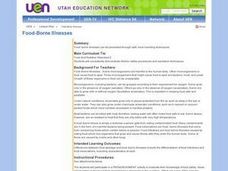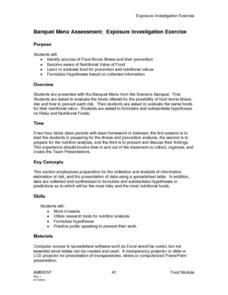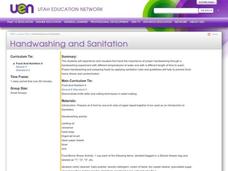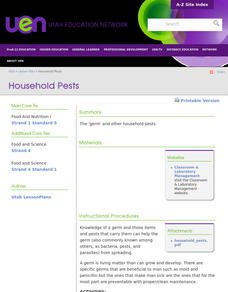Curated OER
Food-Borne Illnesses
Use this lesson to have your charges consider the differences between food spoilage and food-borne illnesses including the differentiation of food infections and food intoxication, including characteristics of each. Some excellent...
Curated OER
Educate Yourself About Food Borne Illness
Students explore the rules to food safety and how to keep foods from growing bacteria. In this food illness lesson students view a demonstration about bacteria complete a food safety test online.
Curated OER
Banquet Menu Assessment: Exposure Investigation Exercise
Students identify sources of Food Borne illness and their prevention. They formulate hypotheses based on collected information. Pupils become aware of Nutrintional value of food. Students collected data are synthesized to formulate...
Curated OER
Food Safety
Students recognize that safe food preparation is important to good health. In this food safety instructional activity, students participate in an activity students separate, clean, chill, and cook food safely. Students use Glo Germ...
Curated OER
Handwashing and Sanitation
Students experience and visualize first hand the importance of proper hand washing through a hand washing experiment with different temperatures of water and with a different length of time to wash. They prevent food-borne illness and...
Curated OER
Health: Food Borne Illnesses
Students discover how to inhibit food borne illnesses by practicing safe food-handling techniques. Among topics they examine are the advantages and disadvantages of using wooden or plastic cutting boards. After studying for the test,...
Curated OER
Foods ll Introductory Review
Ninth graders identify and explain the appropriate use and care of basic kitchen equipment. They assess their skill level to determine to what extent to cover the basics in kitchen equipment, microwave cooking, abbreviations,...
Curated OER
Bacteria
Students study food borne illnesses and what foods are more likely to carry them. In this investigative instructional activity students examine harmful bacteria.
Curated OER
Household Pests
Identify methods that prevent food-borne illnesses and contamination. National Standard 14.4.1 Identify food-borne illness Identify types of food-borne illness and their symptoms: botulism, e-coli, hepatitis, salmonella, staphylococci...
Curated OER
Food Preservation
Students examine the different food canning methods and how to be safe canning. In this canning lesson students examine the hazards of improperly canning.
Curated OER
How Did That Get in My Lunch?
Young scholars view "The Danger Zone" to learn about food poisoning and the bacterial causes and prevention. Students look at slides, use a worksheet, "Microbial Bugs"and the internet to identify and learn about each bacterium.
Curated OER
Scenario Introductory Menu Exercise
Seventh graders engage in a lesson that investigates the sources of Food Borne Illness. The practices of prevention are covered in the lesson. Various foods are looked at for the nutritional value and evaluated for the practices needed...
Curated OER
Handwashing and Sanitation
Learners apply Glo-Germ to their hands to see the amount of germs on their skin. As a class, they watch a demonstration on how to properly watch their hands to prevent the spread of disease. To end the lesson, they are introduced to the...
Curated OER
It's Under Control
Students identify six effective ways to prevent food borne illness in the home. They develop the ability to responsibly and safely handle food, from purchase to preparation. Students comprehend just how susceptible food can be to...
Curated OER
I Can Balance. You Can Balance.
It's disturbing to think that one third of children born after the year 2000 will suffer from diabetes and perhaps be the first generation to live shorter lives than their parents! Too many youngsters are not eating properly and are not...
Curated OER
Kitchen Introduction Unit Test
Students complete a test demonstrating their knowledge of kitchen safety, sanitation, equipment, measuring, cooking terms, abbreviations, substitutions, equivalents, reading and parts of a recipe, and the microwave oven.















